

Trees. Coconutti. Fruit bodies. Tangaloa. Tangaloa the craftsman was the God of the carpenters who use to throw food upward into the air before eating as an offering saying for Tangaloa".

The bird called plover is sacred to him, as this was the shape Tangaloa would take to come to the earth. The plover bird is also famous for pecking at Mauis eye as he lay on the beach at Lofanga in Ha'apai hence the nick name of Maui as torn eye. Tangaloa Prime Hardwood Technical Information. Technical Information Basic Resource The raw source material for Tangaloa Prime hardwood is the common coconut tree (cocos nucifera), also referred to by Tangaloa as coco timber trees.
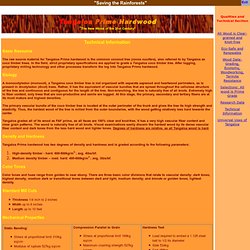
In the field, strict proprietary specifications are applied to grade a Tangaloa coco timber tree. After logging, proprietary milling technology and other processes transform the log into Tangaloa Prime hardwood. Biology. TANGALOA FREQUENTLY ASKED QUESTIONS (FAQS) The environments of copra plantations are man-made farming operations.

Therefore, harvesting coco palm trunks for milling has no impact on any natural environment. Coco palm trees are planted in rows, with 10 to 20 meters between trees, leaving ample room between trees for logging. As with any farming operation, roads are part of any layout and most locations abut existing main roads. In abandoned plantations, some owners do crop farming (mostly root crops) between the trees, pasture livestock or, as in most cases, let the ground lie fallow with dense overgrowth of weeds and local grasses.
Operating plantations tend to keep the ground between trees cleared. Coconut timber. Coconut timber is a hardwood-substitute from coconut palm trees.
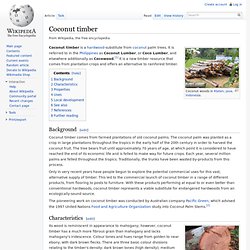
It is referred to in the Philippines as Coconut Lumber, or Coco Lumber, and elsewhere additionally as Cocowood.[1] It is a new timber resource that comes from plantation crops and offers an alternative to rainforest timber. Background[edit] Copra. Product information Product name (* EU Combined Nomenclature/Harmonized System) Product description.

Copra. Whole dry coconuts, kept for sale in Ulsoor Market, Bangalore, India Copra is the dried meat, or kernel, of the coconut used to extract coconut oil.

The earliest evidence of the extracting and usage of coconut oil from copra is found in early Tamil literature from the 1st century AD.[1] The word originated from the Malayalam word Copra (കൊപ്ര).[2] Coconut oil is extracted from it and this has made copra an important agricultural commodity for many coconut-producing countries. It also yields coconut cake which is mainly used as feed for livestock. Production[edit] Copra has traditionally been grated and ground then boiled in water to extract coconut oil. Once the oil is extracted, the remaining coconut cake is 18-25% protein but contains so much dietary fiber it cannot be eaten in large quantities by humans. Cocos-coconut. Cocos nucifera (Coconut) Cocos nucifera (Coconut Palm) Life > eukaryotes > Archaeoplastida > Chloroplastida > Charophyta > Streptophytina > Plantae (land plants) > Tracheophyta (vascular plants) > Euphyllophyta > Lignophyta (woody plants) > Spermatophyta (seed plants) > Angiospermae (flowering plants) > Monocotyledons > Order: Arecales > Family: Arecaceae Coconut Palms are native to the Indo-Pacific Ocean region and grow at the top of beaches, at the limit of wave action.
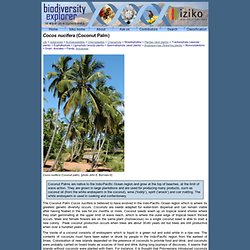
They are grown in large plantations and are used for producing many products, such as coconut oil (from the white endosperm in the coconut), wine ('toddy'), spirit ('arrack') and coir matting. The white endosperm is used in cooking and confectionery. The Coconut Palm Cocos nucifera is believed to have evolved in the Indo-Pacific Ocean region which is where its greatest genetic diversity occurs. The inside of a coconut consists of endosperm which is liquid in a green nut and solid white in a ripe one.
Uses Links. Cocos nucifera var. 'Spicata dwarf' - Palmpedia. From Palmpedia Grove of red spicata Fairchild FL..
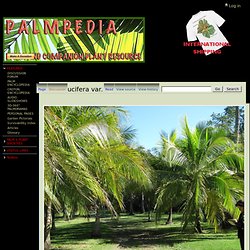
If you know anything at all about this palm, please consider adding some information. Remember this is a group effort, and any registered member can contribute, change, or correct the text, and even add photos on this page. Click on the edit tab above and experiment. Any mistake can be easily corrected, so don't be afraid. Habitat and Distribution Cultivar. Description This variety gets only 20' tall, with a thinner than usual trunk, and smaller crown of fronds. Culture.
Cocos nucifera - Coconut palm. Cocos nucifera Coconut Palms. Coconut oil. A cracked coconut and a bottle of coconut oil Coconut oil, or copra oil, is an edible oil extracted from the kernel or meat of mature coconuts harvested from the coconut palm (Cocos nucifera).
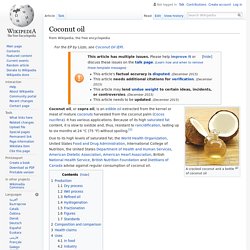
It has various applications. Because of its high saturated fat content, it is slow to oxidize and, thus, resistant to rancidification, lasting up to six months at 24 °C (75 °F) without spoiling.[1] Due to its high levels of saturated fat, the World Health Organization, United States Food and Drug Administration, International College of Nutrition, the United States Department of Health and Human Services, American Dietetic Association, American Heart Association, British National Health Service, British Nutrition Foundation and Dietitians of Canada advise against regular consumption of coconut oil. Production[edit] Dry process[edit] The Alternative Daily Special Report: The Coconut Oil Secret Exposed. (3 of these are shocking) Plus, Four “Common Yet Dangerous” Oils You Should Never Eat...
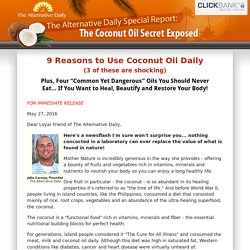
If You Want to Heal, Beautify and Restore Your Body! May 27, 2016 Dear Loyal Friend of The Alternative Daily, Jake Carney, Founder The Alternative Daily Here's a newsflash I'm sure won't surprise you... nothing concocted in a laboratory can ever replace the value of what is found in nature! Mother Nature is incredibly generous in the way she provides - offering a bounty of fruits and vegetables rich in vitamins, minerals and nutrients to nourish your body so you can enjoy a long healthy life. One fruit in particular - the coconut - is so abundant in its healing properties it's referred to as "the tree of life. " The coconut is a "functional food" rich in vitamins, minerals and fiber - the essential nutritional building blocks for perfect health.
Edible. Vegetarian. We Are What We Eat. Well Health Supplements. Healing Herbal. Industrious Plants.